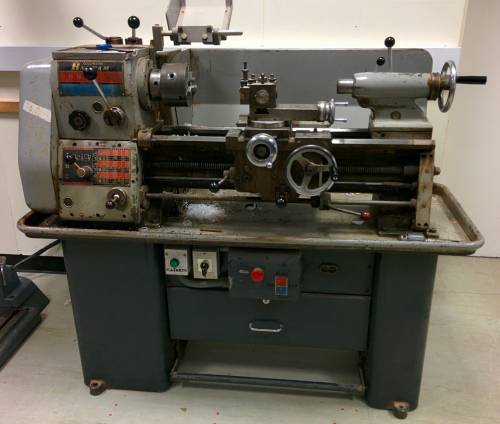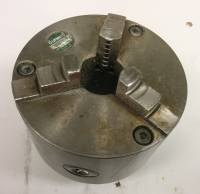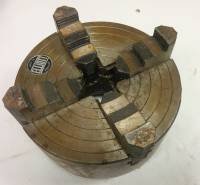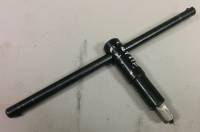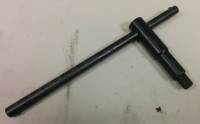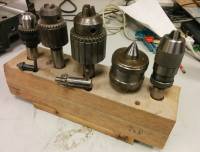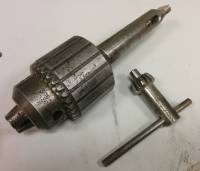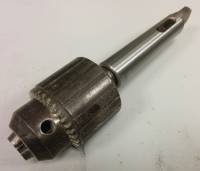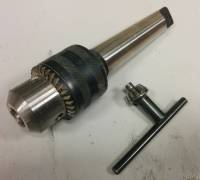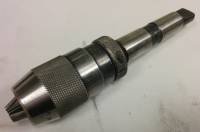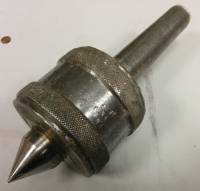bantam_lathe
Table of Contents
Colchester Bantam Mk1 Lathe
Specs
| Model | Condor 20 |
| Chuck mounting | D1-3 camlock |
| Spindle taper | 4MT |
| Tailstock taper | 3MT |
| Leadscrew | 6mm pitch |
| Toolpost | Dickson T1 |
Accessories
Risk Assessment (WIP)
Please see linked page for a full risk assessment of the lathe: Bantam lathe risk assessment.
| Hazard | Risk | Mitigation |
|---|---|---|
| Trapping / Pinching | Closing movements between tools, workpieces and other machine parts under power feed can present a trapping hazard. | Machine users are to ensure they are well aware of their environment and other workshop users, and must disengage power feed and make the machine safe if distracted. Before starting the machine, users should ensure that both the power feed & threading lead screw are disengaged |
| Flying parts | Workpieces (and chuck keys or tools) can be ejected violently if not held correctly | The lathe should not be started until the user has confirmed the workpiece and tool is properly secured, the chuck key is removed, and the work area / machine ways are completely clear. The headstock should not be used to store parts / tools as these can fall into the spinning machinery. Self-ejecting/spring-loaded chuck keys are advised. |
| User injury | Contact with rotating parts and hot swarf can cause cuts, abrasions and burns. | Appropriate feeds and speeds should be selected to minimise stringy chips/“birdnesting”. Users should not attempt to clear chips with the machine running. Metal chips should not be handled directly: use pliers to clear nested chips, a brush to clear loose chips, and heavy gloves should be worn when clearing the chip tray by hand. NB: Gloves should not be worn whilst the machine is in operation - see below. Eye protection must be worn. |
| Entanglement | Long hair, dangling jewellery, loose clothing or gloves can become entangled with rotating parts, dragging the user onto them. Application of cutting oil using a brush presents an entanglement risk. | Loose clothing should not be worn, or should be covered with an appropriately secured apron. Long hair is to be tied back. Loose jewellery should be removed. Gloves should not be worn when the machine is in operation. |
| Lack of space/pushing by others | Limited space can cause the user of the lathe to be pushed by other people in the space. | Area surrounding the lathe should be closed of when in use. |
| Slips and trips | Spilled cutting oil can make the area around the machine slippery. | Appropriate footwear should be worn. Prompt removal of spilled cutting oil. |
| Electrical hazards | Electrical shock due to damaged wiring. | Regular PAT testing. Inspection of cables prior to use. |
| Fire | Hot flying metal pieces igniting surrounding flammable material. | Ensure surrounding area is clear of flammable material. Particular attention must be paid to nearby sawdust accumulation. Fire extinguishers are available in the vicinity of the machine. |
| Lone Working |
Temporary list of hazards / machine health concerns
- Entanglement with the spindle, chuck, workpiece or feed mechanism.
- Being pushed in by other users due to lack of space.
- Unsecured spinning things flying off - chuck key, loose work, things falling from the headstock onto the chuck.
- Sharp/hot metal chips.
- Entanglement in the belts/gearing behind the cover.
- Collisions between chuck/workpiece & toolholder/cross-slide/tool.
- Taking overly-heavy cuts and stalling the machine or breaking something.
- Collisions due to power-feed/threading.
- Damage to VFD from E-Stop overuse.
- Damage to lathe gearing from starting the lathe out of gear, or adjusting gears during running.
- Loose tool/toolholder/slides being pulled into workpiece.
- Unintended use of power-feed/threading at startup.
- Obstruction of brake lever.
- Misconfiguration of VFD.
- Oil or items on the floor causing slipping/tripping.
- Burns - Hot tools / workpiece
- Fire - hot oil / work / use of solvents (e.g. for marking) / machining plastics
- Fumes - melting plastic workpieces
- Oil spray - e.g. getting in eyes
- Electric shock (if cables are damaged)
- Lone working / how to get help
Log
- 2016-10-26 - Lathe delivered
- 2016-10-31 - Spindle oil changed (~3L) & gearbox oil filled (~1.5L). Gearbox oil was almost empty so may need to monitor/check for wear. The oil was 'Hydraulic oil ISO 32' from Westway Lubricants (sold as an equivalent to Shell Tellus 27).
- 2023-06-29 - Topped up the spindle oil, it had dropped to the bottom edge of the sight glass. There is a slight leak from around the rear spindle bearing, but probably more effort than it's worth to investigate/fix.
bantam_lathe.txt · Last modified: 2023-07-05 19:46 by mike
